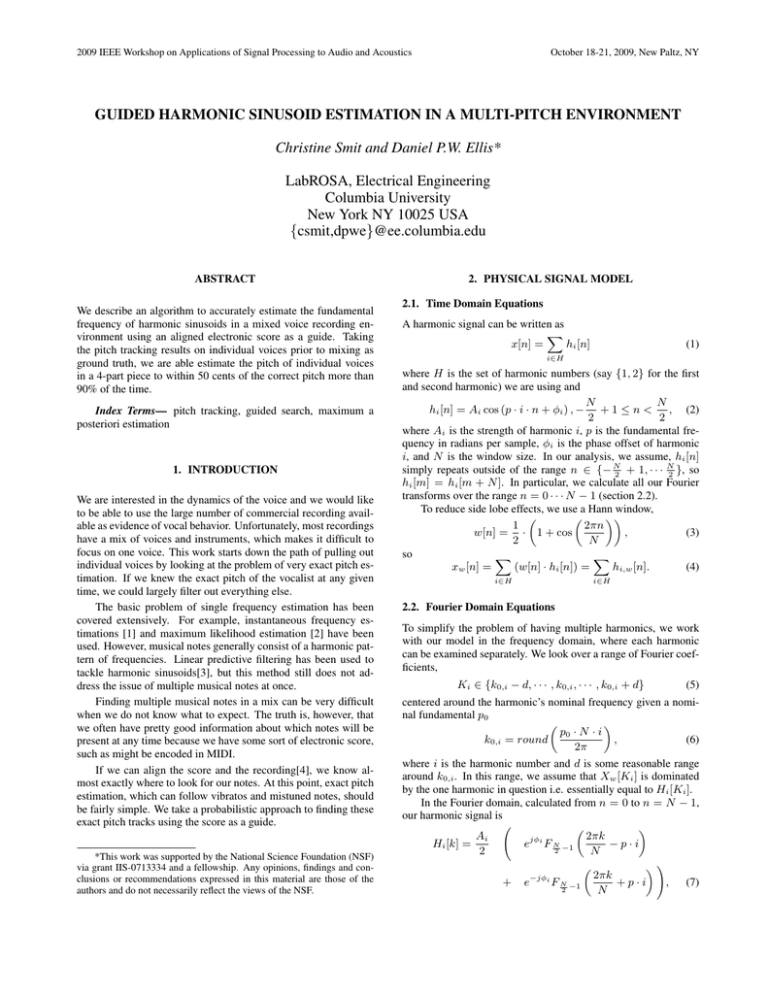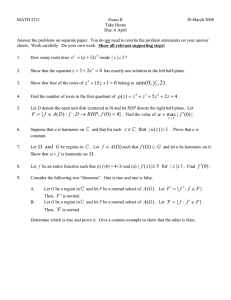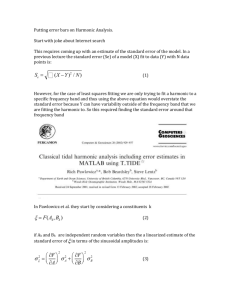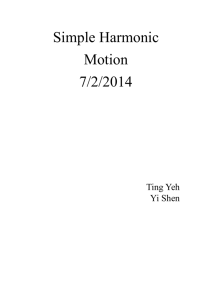2009 IEEE Workshop on Applications of Signal Processing to Audio and... October 18-21, 2009, New Paltz, NY
advertisement

2009 IEEE Workshop on Applications of Signal Processing to Audio and Acoustics
October 18-21, 2009, New Paltz, NY
GUIDED HARMONIC SINUSOID ESTIMATION IN A MULTI-PITCH ENVIRONMENT
Christine Smit and Daniel P.W. Ellis*
LabROSA, Electrical Engineering
Columbia University
New York NY 10025 USA
{csmit,dpwe}@ee.columbia.edu
ABSTRACT
We describe an algorithm to accurately estimate the fundamental
frequency of harmonic sinusoids in a mixed voice recording environment using an aligned electronic score as a guide. Taking
the pitch tracking results on individual voices prior to mixing as
ground truth, we are able estimate the pitch of individual voices
in a 4-part piece to within 50 cents of the correct pitch more than
90% of the time.
Index Terms— pitch tracking, guided search, maximum a
posteriori estimation
1. INTRODUCTION
We are interested in the dynamics of the voice and we would like
to be able to use the large number of commercial recording available as evidence of vocal behavior. Unfortunately, most recordings
have a mix of voices and instruments, which makes it difficult to
focus on one voice. This work starts down the path of pulling out
individual voices by looking at the problem of very exact pitch estimation. If we knew the exact pitch of the vocalist at any given
time, we could largely filter out everything else.
The basic problem of single frequency estimation has been
covered extensively. For example, instantaneous frequency estimations [1] and maximum likelihood estimation [2] have been
used. However, musical notes generally consist of a harmonic pattern of frequencies. Linear predictive filtering has been used to
tackle harmonic sinusoids[3], but this method still does not address the issue of multiple musical notes at once.
Finding multiple musical notes in a mix can be very difficult
when we do not know what to expect. The truth is, however, that
we often have pretty good information about which notes will be
present at any time because we have some sort of electronic score,
such as might be encoded in MIDI.
If we can align the score and the recording[4], we know almost exactly where to look for our notes. At this point, exact pitch
estimation, which can follow vibratos and mistuned notes, should
be fairly simple. We take a probabilistic approach to finding these
exact pitch tracks using the score as a guide.
*This work was supported by the National Science Foundation (NSF)
via grant IIS-0713334 and a fellowship. Any opinions, findings and conclusions or recommendations expressed in this material are those of the
authors and do not necessarily reflect the views of the NSF.
2. PHYSICAL SIGNAL MODEL
2.1. Time Domain Equations
A harmonic signal can be written as
X
x[n] =
hi [n]
(1)
i∈H
where H is the set of harmonic numbers (say {1, 2} for the first
and second harmonic) we are using and
N
N
hi [n] = Ai cos (p · i · n + φi ) , − + 1 ≤ n < , (2)
2
2
where Ai is the strength of harmonic i, p is the fundamental frequency in radians per sample, φi is the phase offset of harmonic
i, and N is the window size. In our analysis, we assume, hi [n]
simply repeats outside of the range n ∈ {− N2 + 1, · · · N2 }, so
hi [m] = hi [m + N ]. In particular, we calculate all our Fourier
transforms over the range n = 0 · · · N − 1 (section 2.2).
To reduce side lobe effects, we use a Hann window,
1
2πn
w[n] = · 1 + cos
,
(3)
2
N
so
X
X
xw [n] =
(w[n] · hi [n]) =
hi,w [n].
(4)
i∈H
i∈H
2.2. Fourier Domain Equations
To simplify the problem of having multiple harmonics, we work
with our model in the frequency domain, where each harmonic
can be examined separately. We look over a range of Fourier coefficients,
Ki ∈ {k0,i − d, · · · , k0,i , · · · , k0,i + d}
(5)
centered around the harmonic’s nominal frequency given a nominal fundamental p0
p0 · N · i
k0,i = round
,
(6)
2π
where i is the harmonic number and d is some reasonable range
around k0,i . In this range, we assume that Xw [Ki ] is dominated
by the one harmonic in question i.e. essentially equal to Hi [Ki ].
In the Fourier domain, calculated from n = 0 to n = N − 1,
our harmonic signal is
Ai
2πk
Hi [k] =
ejφi F N −1
−p·i
2
2
N
!
2πk
−jφi
+ e
F N −1
+p·i
,
(7)
2
N
2009 IEEE Workshop on Applications of Signal Processing to Audio and Acoustics
October 18-21, 2009, New Paltz, NY
3. MAXIMUM A POSTERIORI ESTIMATION
where
M
θ
FM (θ) = 2 cos θ ·
sincM +1
−1
2
2
(8)
and sinc is a periodic sinc function,
sincM (θ) =
sin(θM )
.
sin(θ)
(9)
We calculate a maximum a posteriori (MAP) estimate of the pitch,
p. Because we have no reasonable way of knowing in advance the
harmonic strengths, Ai∈H , and phases, φi∈H , we estimate these
in addition the noise parameters, σn,i∈H . So,
θ̂ MAP = argmax P r (θ|Y , p0 ) ,
(21)
θ
The Hann window has a simple 3-point Fourier Transform, so
the windowed harmonic signal is simply
1
1
1
Hw,i [k] = Hi [k] + Hi [k − 1] + Hi [k + 1]
(10)
2
4
4
where θ is a vector of our parameters, [p, Ai∈H , φi∈H , σn,i∈H ],
Y is the Fourier transform of our windowed input, and p0 is the
nominal pitch in our current window.
2.3. Noise model
3.1. Defining probabilities
Because the real world has noise, we model the noise around each
harmonic,
Y [Ki ] = Hw,i [Ki ] + Nw,i [Ki ]
(11)
Using Bayes, we can say that
where Y [Ki ] is the Fourier transform of our full input around harmonic i and Nw,i [Ki ] is the noise around harmonic i.
Let us start with broad-band white noise in the time domain,
2
ni [n] ∼ N (0, σn,i
).
(12)
In the Fourier domain, it is easier to notate Ni [k] as a vector,
N i , and we have that
P r (N i ) = P r (< (N i )) · P r (= (N i ))
(13)
because the real and imaginary parts of N i are independent. Furthermore,
2
P r (< (N i )) ∼ N 0, σn,i
· ΣR
(14)
and
2
P r (= (N i )) ∼ N 0, σn,i
· ΣI ,
(15)
where ΣR and ΣR are both N × N dual diagonal matrices
offset by one row and one column. Using zero-indexing, where k
is the row and l is the column,
N
if k = l = 0 or N2
1
N
if
k = l, k 6= 0, k 6= N2
2
ΣR (k, l) =
(16)
1
N
if k = N − l, k 6= 0, k 6= N2
2
0
elsewhere
and
ΣI (k, l) =
1
N
2
− 12 N
0
if k = l, k 6= 0, k 6= N2
if k = N − l, k 6= 0, k 6=
elsewhere.
N
2
(17)
For the windowed noise, N w,i , the real and imaginary parts
are similarly independent and we have that
2
P r (< (N w,i )) ∼ N 0, σn,i
· BΣR B T
(18)
and
2
P r (= (N w,i )) ∼ N 0, σn,i
· BΣI B T
where B is an N × N
1
2
1
B(k, l) =
4
0
(19)
matrix,
if k = l
if k = l − 1 or l + 1
elsewhere.
(mod N )
(20)
Since we are looking at Nw,i only around harmonic i, to calculate P r(Nw,i [Ki ]), we simply use the submatrices ΣR (Ki , Ki )
and ΣI (Ki , Ki ) as the covariances of the real and imaginary parts
of the noise. Thus, our noise model is a narrow-band piece of
broad-band white Gaussian noise.
P r (θ|Y , p0 ) ∝ P r (Y |θ, p0 ) P r (θ|p0 ) .
(22)
For the prior, P r (θ|p0 ), we simply want to capture the idea that
the pitch of the current window, p, should be close to the nominal
pitch from our score, p0 , so we assign
P r (θ|p0 ) ∝ P r (p|p0 ) ∼ N (p0 , σp2 )
(23)
σp2
is the variance we expect around p0 .
Returning to equation 22, and assuming that Y only depends
on the nominal pitch p0 via the actual pitch p, we define
Y
P r (Y |θ, p0 ) =
P r (Y [Ki ] | Ai , φi , σn,i , p) .
(24)
and
i∈H
i.e. we combine the information from different harmonics by assuming that the conditional probabilities associated with each harmonic, P r (Y [Ki ] | Ai , φi , σn,i , p), are independent. Since the
signal spectrum Hi [Ki ] is completely specified by the givens in
equation 24, we can calculate Nw,i [Ki ] = Y [Ki ] − Hi [Ki ], so
P r (Y [Ki ] | Ai , φi , σn,i , p) = P r (Nw,i [Ki ] | σn,i ) ,
(25)
3.2. Finding the maximum
Finding the maximum of eqn. 22 directly is difficult, so we opted
to search for a solution using the Nelder-Mead Simplex Method[5]
as implemented by Matlab’s fminsearch(), but any suitable maximization algorithm could be used. The main difficulty lies in seeding the search algorithm sufficiently close to the global optimum
to avoid local maxima.
Our first step was to calculate approximate values for p and
Ai∈H . We first observed that
Ai
2πk
Hi [Ki ] ≈
FN
− p · i ejφi ,
(26)
2 2 −1
N
so, via eqn. 10 we have an expression for |Xw [Ki ]| ≈ |Hw,i [Ki ]|
which is only a function of p and Ai∈H . We also observed that
near the peak values of |Yw [k]|,
|Yw [Ki,peak ]| ≈ |Xw [Ki,peak ]|,
(27)
where Ki,peak consisted of the two largest values next to each
other in |Yw [Ki ]| for each harmonic i. Our initial estimates are
thus a best fit of p and Ai∈H to the approximation in eqn. 27. Initial phases φi were simply the phase of the peak value of Yw [Ki ],
φi ≈ 6 Yw [argmax |Yw [k ∈ Ki,peak ]|].
(28)
k
For the estimate of σn,i , we noted that in eqns. 18 and 19,
2
the noise covariance scales linearly with σn,i
. Our estimates of
p, Ai∈H , and φi∈H were not always good enough to calculate
2009 IEEE Workshop on Applications of Signal Processing to Audio and Acoustics
Nw [Ki ] accurately from Yw [ki ], particularly around the peaks. So,
2
we estimated each σn,i
from the non-peak values of Yw [Ki ],
P
2
i∈Ki \Ki,peak |Nw [i]|
2
.
σn,i ≈ P
P
T
+ i∈Ki \Ki,peak BΣI B T
i∈Ki \Ki,peak BΣR B
(29)
Thus, for a given window of the original signal, we derive
initial estimates of p and Ai∈H using eqns. 26 - 27, φi∈H from
eqn. 28, and σn,i∈H using eqn. 29. These values are passed to the
optimizer to maximize eqn. 22, as defined in eqns. 23 - 25.
4. EXPERIMENTS
We first tested our algorithm on simulated data with two harmonics. We varied the power of each harmonic in the signal, while
keeping the overall signal power constant. As shown in Figure 1,
our algorithm was able to adapt to the varying harmonic power
and maintain a good estimate of the fundamental frequency, and is
unperturbed as energy is shifted between harmonics.
Median error (cents)
Combining harmonics for improved estimation
October 18-21, 2009, New Paltz, NY
notes per track. Our algorithm used the first and third harmonics
for its frequency estimates.
As you can see in Table 1, our algorithm produced substantially the same results as YIN when they were both run on individual tracks, with the algorithms agreeing to within 50 cents (a
quarter step) in 98.9% of windows. When our algorithm was run
on the mix of voices, it was still able to find the correct pitch,
within 50 cents, in more than 90% frames. The table also shows
how YIN faired on the full mix, but told to only consider frequencies within a whole step of the nominal frequency. It was close to
the actual frequency less than 50% of the time. We were frankly
surprised that YIN did this well, considering that it is not designed
to deal with multiple pitches at once. Finally, the table includes the
results from naively guessing the nominal frequency of the note in
each window, which differed from the tracked pitch by an average
of about a quarter step – significantly larger than the results of our
algorithm. Figure 3 shows histograms of these errors.
Prob (single)
Prob (mix)
YIN (mix)
f0
RMSE (Hz)
0.743
4.15
31.1
8.45
RMSE (cents)
4.77
24.8
162
49.7
% < 50 cents
98.9
91.4
45.9
52.4
40
30
20
just harm. 1
just harm. 2
both harm.
10
0
0
0.04
0.01
0.03
0.02
0.02
0.03
0.01
0.04 2nd harm.
0 1st harm.
Harmonic power (0.5*A 2)
i
Figure 1: Fundamental tracking as power shifts between harmonics. At the left-most point, all signal power is in the fundamental,
but by the right-most point, it has all transferred to the 2nd harmonic. Signal power, measured before windowing, is at 0.01×
(broadband) noise power. Plus symbols show result of estimation
based on both harmonics, circle and triangle symbols show results
based only on first and second harmonics, respectively.
We also tested our algorithm on a multi-track recording[6] of
the opening to Guillaume de Machaut’s Kyrie in Messe de Nostre
Dame (c. 1365). Each of the four voices had been recorded individually and had been labeled with accurate start and stop times
for each note. To obtain truth data for the pitch, we ran the well
known fundamental frequency estimation algorithm YIN[7] over
each individual track. For comparison purposes, we ran our own
algorithm over the individual tracks as well as on the full mix.
The YIN algorithm actually permits specification of a frequency
search range, so we tried running YIN on the full mix, using the
same guided search range that our algorithm used.
For these experiments, we chose a search range of 1 whole
step below, and the same number of Hz above, the nominal pitch
p0 . Our window length was 4096 samples (approximately 93 ms
at 44.1 kHz) and our hop size was 1024 points for a 75% overlap
between successive windows. This lead to about 1000 frames in
Table 1: Pitch tracking results on Machaut data, compared to YIN
results on individual tracks. “Prob(single)” is the results of applying our probabilistic model to the individual tracks. “Prob(mix)”
is the model applied to the 4-voice mixdown. “YIN(mix)” is YIN
applied to the mixdown, and “f0” is the result taking the nominal
(notated) pitch as the result.
Figure 2 illustrates the results of our experiments on one particular voice, the triplum line. As you can see in the top plot, YIN
does an excellent job of following the pitch in the single track case;
note the singer’s vibrato at around 8 seconds. However, as the bottom plot shows, YIN cannot accommodate the mix of voices, even
when given the correct frequency search range. In contrast, our
algorithm generally finds a harmonic, which is mostly the correct
fundamental.
5. DISCUSSION AND CONCLUSIONS
There are several novel advantages to our solution. First, unlike
most pitch estimation algorithms, our solution is geared towards
multiple simultaneous pitches. Secondly, our algorithm is able to
adaptively weight the information it receives from different harmonics, depending on its local signal-to-noise ratio. A weak harmonic in a lot of noise affects our estimate less strongly than a
strong harmonic with little noise. This results from the explicit
optimization of the noise level in the vicinity of each harmonic.
A further advantage to our model is that it not only gives you a
estimate of the fundamental frequency, it also gives you a goodness
of fit measure in the probability calculations. Defining the solution
in terms of a distribution also leaves the possibility open of using
other tools from probability theory.
One limitation of our current algorithm is that it myopically
searches for a single pitch in any given window even though we
actually know approximately where interfering harmonics may lie.
We suspect that we could improve further on our algorithm by using this knowledge either during the initial approximation stage or
during the optimization stage.
2009 IEEE Workshop on Applications of Signal Processing to Audio and Acoustics
Frequency (Hz)
Spectrogram of triplum track: YIN (red)
700
30
500
20
400
300
200
Our algorithm is also quite slow. Because we do not have a
direct solution to eqn. 21, we are forced to rely on an iterative
algorithm to find the best solution. The speed of our algorithm is
essentially a function of the speed of our optimizer and the goodness of our initial starting point.
Furthermore, the complexity of our algorithm grows with the
number of harmonics we include in the estimate. Fortunately, the
number variables over which we optimize eqn. 21 grows linearly
with the number of harmonics. Unfortunately, even a linear increase in variables can cause the optimization routine to slow down
considerably, which is why we have reported results with no more
than two harmonics.
We believe that there are many other applications to this work.
Obviously, there is no reason our model should not work for most
other instruments. In fact, it should work wherever there is some
way to calculate the constituent frequencies of a signal from the
base frequency. So the slightly de-tuned harmonics found on the
piano could easily be modeled. Furthermore, the accuracy of the
pitch estimation lends itself to the study of many pitch-based phenomena such as tuning. We hope that the ability of this algorithm
to recover detailed tuning nuances from recordings of real performances will make possible a broad new range of data-driven musicological investigation1 .
40
600
10
5
6
7
8
9
10
dB
Frequency (Hz)
Spectrogram of combined trackes: YIN (red), Prob (blue)
700
40
600
30
500
20
400
300
200
10
5
6
7
8
Time (s)
9
10
October 18-21, 2009, New Paltz, NY
dB
6. REFERENCES
Figure 2: Spectrograms of 5 s excerpts from the multi-track
recordings. The top plot shows a single track and the ground from
YIN (red). The bottom plot shows a spectrogram of the mix with
the full-mix YIN estimates (red) and our full-mix estimates (blue).
Note the large difference between algorithms at around 9 s. Here,
the correct fundamental is at about 365 Hz, but there is an interfering harmonic at about 320 Hz, which our algorithm jumps to.
[1] B. Boashash, “Estimating and interpreting the instantaneous
frequency of a signal. i. fundamentals,” Proceedings of the
IEEE, vol. 80, no. 4, pp. 520–538, 1992.
[2] R. Kenefic and A. Nuttall, “Maximum likelihood estimation
of the parameters of a tone using real discrete data,” Oceanic
Engineering, IEEE Journal of, vol. 12, no. 1, pp. 279–280,
1987.
Number of windows in bin
[3] K. Chan and H. So, “Accurate frequency estimation for real
harmonic sinusoids,” Signal Processing Letters, IEEE, vol. 11,
no. 7, pp. 609–612, 2004.
[4] R. Turetsky and D. Ellis, “Ground-truth transcriptions of real
music from force-aligned midi syntheses,” in Proc. International Conference on Music Information Retrieval, Baltimore,
Oct. 2003.
Histograms of frequency estimation errors
1000
800
600
Prob (single)
Prob (mix)
Yin (mix)
[5] J. C. Lagarias, J. A. Reeds, M. H. Wright, and P. E.
Wright, “Convergence properties of the nelder–mead simplex
method in low dimensions,” SIAM Journal on Optimization,
vol. 9, no. 1, pp. 112–147, 1998. [Online]. Available:
http://link.aip.org/link/?SJE/9/112/1
400
200
0
-50 -40 -30 -20 -10 0
10 20 30
Cents from correct frequency
40
50
Figure 3: Histograms of the errors summarized in Table 1. Plus
signs refer to differences between YIN and the probabilistic algorithm on individual voices. Circles show the errors when each line
is tracked within the mix by the probabilistic algorithm. Triangles
are the same data tracked by YIN. Substantial counts lie outside
the ±50 cent range shown in the plot.
[6] J. Devaney and D. P. Ellis, “An empirical approach to studying intonation tendencies in polyphonic vocal performances,”
Journal of Interdisciplinary Music Studies, vol. 2, no. 1-2, pp.
141–156, 2008.
[7] A. de Cheveigne and H. Kawahara, “YIN, a fundamental
frequency estimator for speech and music,” The Journal
of the Acoustical Society of America, vol. 111, no. 4,
pp. 1917–1930, Apr. 2002. [Online]. Available: http:
//link.aip.org/link/?JAS/111/1917/1
1 The software can be downloaded from http://www.ee.
columbia.edu/˜csmit/papers/waspaa_2009/







